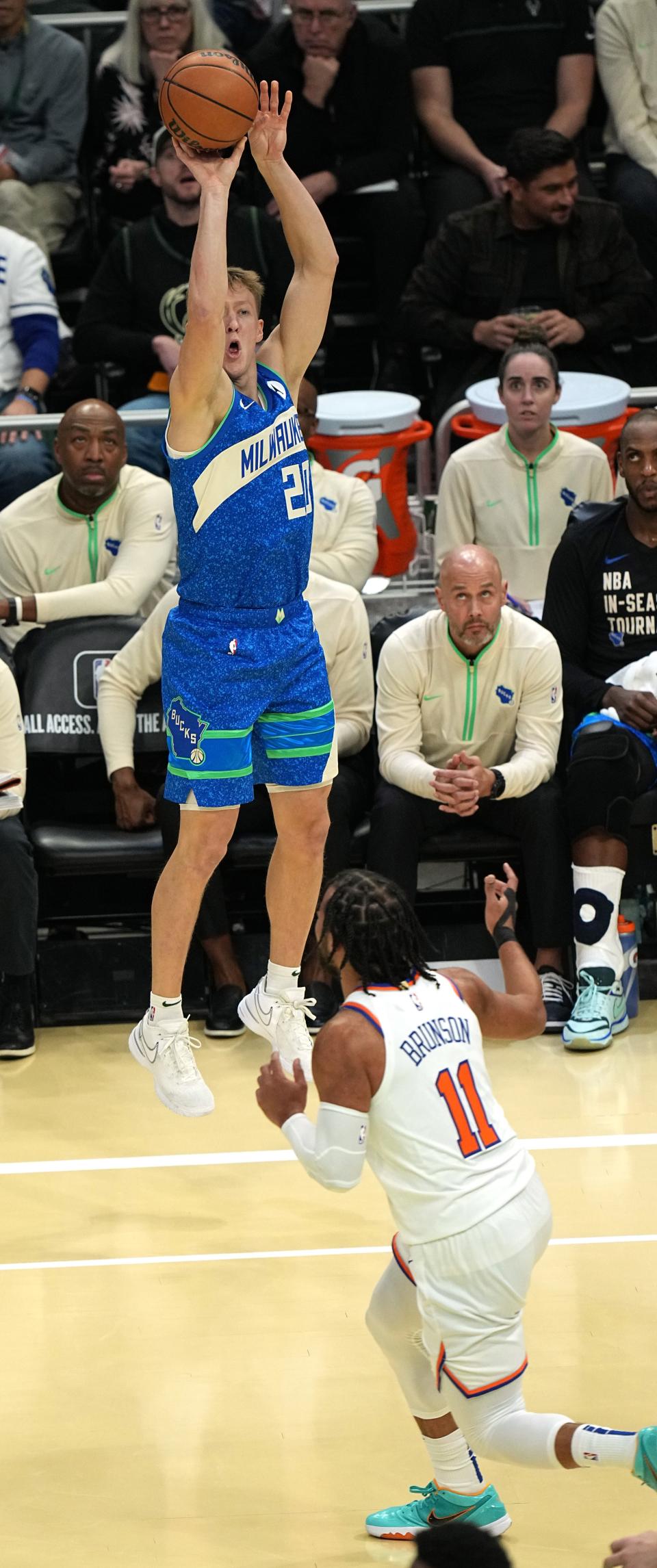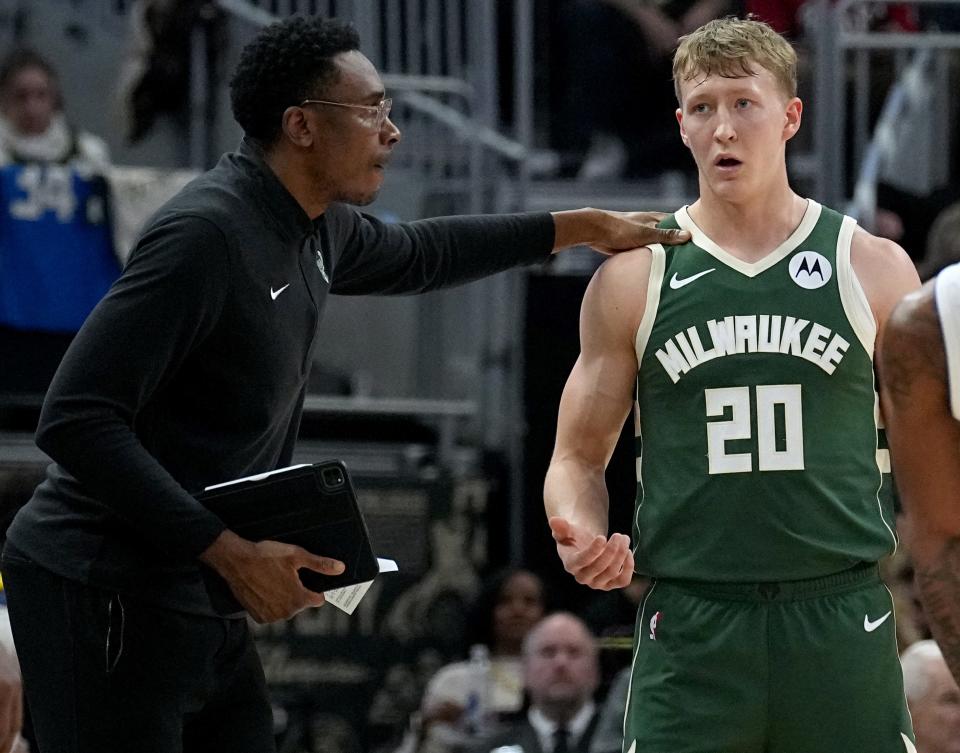How the Bucks' AJ Green comes off the bench ready to shoot
There’s a timeout in the action on the court, and the Milwaukee Bucks walk back to the bench. As they towel off, hydrate and catch their breath, AJ Green sneaks in some activity.
He grabs the game ball and goes through a quick set of dribble drills in the corner, jab stepping forward and then hopping back and rising up into his shooting motion – only he rolls the ball softly skyward as opposed to launching it at the rim.
He’ll sometimes work the baseline, hopping or shuffling. His number may not be called that game, but he must be prepared if it is. NBA courts are chilly, and he’ll blow in his hands, hold hot packs or clap extra hard for his teammates to keep the blood flow going. And when head coach Adrian Griffin has called on him, Green might get two minutes of action. Or 15.
But one thing is for certain – when he’s on the court, he’s there to make threes.

What else is certain is Green’s teammates feel like every time he gets into that shot, the ball is going to rip the nets.
“Every time,” Malik Beasley said with a grin. “Every time.”
“Freakin’ AJ,” Giannis Antetokounmpo said with a shake of his head. “I feel like whenever he shoots the ball, the ball is going in.”
How does the Bucks’ reserve sharpshooter stay ready?
Through focus, and the flow state.
More: Bucks guard A.J. Green has felt right at home in Milwaukee. Here is how he's connected.
AJ Green had to learn to focus in a new role
Like all NBA players Green came up through childhood, high school and college as one of the best players – if not the best player – on his teams. But like many of those players, the NBA brings a dose of reality. Green played over 36 minutes per game in his final two seasons at Northern Iowa, but in his rookie year with the Bucks last season he was on the roster for 22 games (seven appearances) before he reached 36 minutes of total play time.
He knew he was going to have to adjust on the fly and find a way to stay engaged and ready to perform even though he had never been in such a position.
“It took half the season, a good chunk of the season last year, to really where I was comfortable was like I alright, I can come in and if I haven’t touched a ball I’ll still feel good about the shot going up,” he said. “I think part of that is just having to learn it. You have no choice other than to do that. Part of it is things you can try to incorporate within workouts or finding different ways within the game to stay physically ready. Mentally. Just ready across the board. I feel good with it now to where I come in and just ready to impact the game.”
After shooting 42% from behind the arc in 19 games last year, he earned a guaranteed contract for this season. Then this offseason a mentor back home in Iowa – Green smiled and politely declined to identify him – suggested a visual exercise to use while on the bench.
Green put his palms together and raised them up in front of him. He focused his eyes on his fingers, and then quickly darted them to find a rim in the Bucks’ practice facility.
“I do it before every game, sometimes throughout the game,” he said of the exercise. “I’ll look at my hands close, focus here, and see how fast I can find the rim with my eyes. The adjustment. I don’t know. You never know what actually causes it to be able to work, but it’s just something I feel comfortable with doing and I feel like helps me so I’ll do it throughout the game. I do it in my training, how I can find the rim faster with my eyes.”
He feels it’s been a beneficial addition to his in-game mental reps, and though his time has been just as sporadic as a year ago, he’s shooting 43% from distance.
Beasley, one of the league’s top three-point shooters this season, said it’s difficult to come off the bench and be that accurate. Griffin did, too, but noted the work Green puts in physically and mentally keeps him ready.
Like hitting his first two shots of the season against Atlanta on Oct. 29. Or going 7 for 9 from behind the three-point line in a three-game stretch from Dec. 5-11.
“Nothing fazes him,” Griffin said. “It’s tough to sit there all season and not know when your minutes are coming but you can be called on any time.”
AJ Green works on finding a flow state and confidence with shooting
That’s where the flow state comes in.
It is concept founded in sports psychology in 1990, and can be defined as finding a mental state in which a person is completely focused on a single task or activity. Green smiled and acknowledged he’s still trying to figure out what that means for him – and how to truly get into it – but the task of going about it has helped him stay engaged.

For this part of his mental routine, Green credited Bucks team director of sports psychology Cam Robinson.
“When you’re in the game, you just have a feel for everything and you can see things just because you’re playing (so) how can I almost try and replicate that when I’m on the bench?” Green said. “Even if I know I’m playing or I don’t know I’m playing, how can I still be that involved in the game and seeing things? That’s probably the hardest thing because you can’t really replicate it perfectly without playing. I’ve been talking with Cam and he just helps me out with how you can get into flow state, things you can focus on that help you mentally. Mentally if you’re there the rest begins to follow because your body knows how to do stuff. That’s kind of been just the focus lately.”
A corollary for that is handling the actual results once he gets in a game. The shots don’t always go in, of course. And he may only get one. In a cold, results-based business, Green has also had to work mentally to separate that one outcome – good or bad – from his confidence in his ability.
“You can’t correlate how you feel or what defines you just based off what happens,” he said. “Outcome, make or miss, I don’t care about. It’s more like ‘did it feel good?’ OK, that’s all I care about. I’m so in tune with my shot where if there is something I immediately know if I didn’t catch it clean or my feet were imbalanced. I know immediately know for the next time.
"It’s a self-learning and correcting process. As long as it feels good, then I’m not worried if I’m going to make ‘em or I’m going to miss ‘em. Everybody might think it’s going in, but you just gotta – you gotta just have fun and be like, if I make this shot it’s fun and the crowd loves it. Not like oh, I need to make this shot.
"You care but you have to have a sense of it’s not who I am. It’s not going to eat me up the whole time. But of course I care. It’s a balance and it takes time to grow or learn that.”
Green may play a big chunk of time this week. He may not. But he’ll be moving around the bench, the baseline and the court during timeouts, always keeping his hands and his eyes ready, always focused, ready to flow, for two minutes or 15, for one miss or four makes.
“I knew making shots that’s going to be how I’m going to start in the league and how I can build from there,” he said. “I’m blessed with the people around me, too. Value is value and teams need value to win – how can I impact winning? If I can play this game for however long God blesses me to play, I’m going to do it because I love to play.
"I’m not going to let my ego get in the way of oh, I want to play this way or do this. I love to play. So, whatever I can do to help the team in that way, that’s the role I’m going to buy into.”
This article originally appeared on Milwaukee Journal Sentinel: How the Bucks' AJ Green comes off the bench ready to shoot

